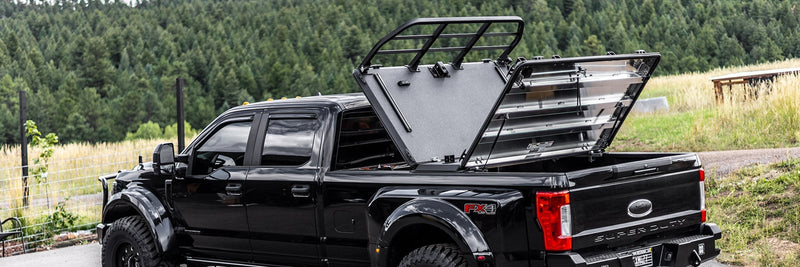Three Things We Learned Driving An F-150 Lightning Across The U.S.
When DiamondBack took delivery of our 2022 F-150 Lightning Lariat, it was welcomed by team members and friends with a flood of questions and a sea of skepticism. We’ve had and still have plenty of our own questions. For starters, is the Ford F-150 Lightning actually a truck? Is it a truck that’s worth the attention it’s getting, and more importantly, is it a truck that’s worth the steep price tag?
The Lightning’s outward appearance is all truck. In fact, a casual observer would have a tough time telling it apart from its best-selling, gas-powered brother. Thing is, we’re not casual observers. Our team of 125+ use pickups heavily in our daily lives, evidenced by the crammed parking lot at HQ. DiamondBack also designs, tests, and builds products for nearly every truck on the road. We know pickups and we’ve learned that, just like with people, it’s what’s beneath the surface that matters.
In September of 2022, just a month after receiving our Lightning, my family and I loaded up and embarked on an ill-advised cross-country tour of the United States. This trip had a number of objectives, not least of which was reporting back to the team what this vehicle is and what this vehicle isn’t.
These are three of our biggest takeaways.

1. The Ford F-150 Lightning Is Definitely A Pickup
Let’s get this one out of the way. People may differ on what qualifies a vehicle as a pickup, but after a month behind the wheel of the Lightning, off-roading, hauling, towing, speeding west on US80, our minds are made up. It uses a fuel source that’s a massive pain (we’ll get to that later), but the thing is an absolute beast once it leaves the charging station, making easy work of mountain climbs, water crossings, and muddy terrain, even with 800 pounds of cargo in the bed. The massive weight of the truck itself (6,590 pounds curb) kept us glued to the road and there was always unlimited power and torque. The vehicle’s efficiency is another story, at least as ours is built, but “fuel efficient” isn’t exactly a traditional pickup quality. Plus, we knowingly sacrificed efficiency by lifting the front of the truck and adding aftermarket wheels and all terrain tires.
Early into our trip, we became convinced that our bed full of gear was partially to blame for our failure to meet Ford’s claim of 300+ miles of range . We considered sending home items that were less than necessary. Instead we opted to deal with the extra weight until our week in Colorado, where we could dump all of our cargo in one secure spot and measure the impact of the reduction. Turns out, the weight didn’t matter much. On steep hill climbs and during highway merges, it felt good to be skinny, but it didn’t save us much time at the chargers. A week of mixed driving after shaving almost 600 pounds equaled a 0.1 mi/kWh improvement over our previous 1.7 mi/kWh average, or an extra 10 miles per charge up to 80%. During our less than scientific towing tests, the battery drain was noticeably higher when getting up to speed. Once cruising, things leveled off. All told, we achieved 1.5 mi/kWh during our short test. We wouldn’t consider using the Lightning to tow outside of our home area simply because it’s tough enough to make it to chargers as it is.

2. Fueling Up Is A Real Downer
Most drivers give little thought to the fuel that powers their vehicle until oil and gas supplies are making the news. You know the Lightning is different, but you probably haven’t given it enough thought to fully comprehend the lifestyle change that comes with owning one.
There are more than 140,000 gas stations in the United States, all of them serving the same three or four grades of unleaded gasoline, plus diesel fuel. Most of us can start a road trip with a full tank and drive in any direction with complete confidence that we’ll have ample opportunities to top off our tank. Occasionally, you may come across a pump that’s down, but that just means a quick jockeying of your truck to the next one, then you’re quickly on your way.
There are approximately 53,000 EV charging stations in the U.S., but there isn’t an electric vehicle that’s compatible with all of them. 19,500 of those stations are compatible with our Lightning. After sorting for compatibility, we’re left with power outputs that are even less predictable than the price of crude. And power outputs, or rather the lack of power output, equals time at the charger. Lots of time.
How much time are we talking about? Well, where a slow gas pump may have you impatiently tapping your feet, a slow charger may mean booking a hotel room. And back to the number of chargers in the U.S., a faster option is rarely around the corner. Just three hours into our cross country trip, before leaving our home state of Pennsylvania, we found ourselves in a Hampton Inn & Suites because the only charging station in town was kicking out below 10kw of power. With our average economy of 1.7 mi/kWh, each hour of charging gave us less than 17 miles of range.
That wasn’t the fastest charger we encountered, but it wasn’t the slowest either. Even along US80, one of our nation's most traveled highways, we regularly came across chargers with as low as 2kW of power. That’s 3.4 miles of range per hour of charging, for those taking notes. Now, aside from a station that’s completely out of commission, 2kW is the worst case scenario. What’s the best case? An ultrafast charger (defined by Ford as 100kW+) which will get you on your way in about 40 minutes. That’s best case, and even with the extended range battery of our Lightning, those 40-minute breaks came every 179 miles.
Even more frustrating is the fact that Ford, via their FordPass app, consistently lists chargers above their actual output, and routes their customers to these chargers based on the bad info. We got better at avoiding slow chargers as our trip went on, especially in more populated areas, but Ford’s app didn’t help matters, and we learned that there’s no avoiding an occasional 2kw charger. That is, unless you stay close to home.

3. There’s No Place Like Home
You’ve probably figured out that we’re not crazy about the Lightning as a road trip vehicle, despite it being plenty capable to get anywhere. It’s not just the constant and slow charging, it’s where that charging occurs. When mapping out our trip, we had hoped to parlay stops for charging into picnics, nature hikes, visits of tourist traps, and the like. That never happened. In reality, the fast chargers were almost all found in Walmart parking lots. We’ve got nothing against an occasional Walmart visit, but that doesn’t cut it on an EV road trip.
If the Lightning isn’t a truck for road trips, what is it? Well, it’s great for anything within 100 miles or so of home base, where plugging in overnight should leave you with a full charge. That’s as long as you’re cool with dropping 80 grand on a commuter that’s tethered to home base. For as long as we’re permitted to by the powers that be, we’ll stick with gas and the open road.


